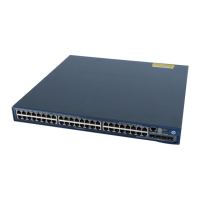34
NOTE:
To ensure stable aggregation state and service continuity, do not change port attributes or class-two
configurations on any member port.
If a static aggregation group has reached the limit on Selected ports, any port that joins the group is placed in
the Unselected state to avoid traffic interruption on the current Selected ports. Avoid this situation, however,
because it might cause the aggregation state of a port to change after a reboot.
Aggregating links in dynamic mode
LACP is automatically enabled on all member ports in a dynamic aggregation group. The protocol
automatically maintains the aggregation state of ports.
The dynamic link aggregation procedure comprises:
Selecting a reference port
Setting the aggregation state of each member port
Selecting a reference port
The local system (the actor) and the remote system (the partner) negotiate a reference port by using the
following workflow:
1. The systems compare the system ID (which comprises the system LACP priority and the system MAC
address). The system with the lower LACP priority value wins. If they are the same, the systems
compare the system MAC addresses. The system with the lower MAC address wins.
2. The system with the smaller system ID selects the port with the smallest port ID as the reference port.
A port ID comprises a port LACP priority and a port number. The port with the lower LACP priority
value wins. If two ports have the same LACP priority, the system compares their port numbers. The
port with the smaller port number wins.
Setting the aggregation state of each member port
After the reference port is selected, the system with the lower system ID sets the state of each member port
in the dynamic aggregation group on its side.

